Development of Sustainable, Low-Shrinkage Concrete Through Optimized Aggregate Gradation, Cement Reduction, and Internal Curing
Abstract
1. Introduction
2. Experimental Program
2.1. Materials
2.2. Sample Preparation
2.3. Experimental Plan
3. Testing Results for Regular Concrete
3.1. Slump Test
3.2. Mechanical Performance
3.3. Bulk Resistivity
3.4. Shrinkage
4. Testing Results for LWFA Concrete
4.1. Mechanical Performance
4.2. Bulk Resistivity
4.3. Shrinkage
5. Sustainability Investigation
5.1. Methodology
5.2. Environmental Impact Analysis
- Global Warming Potential (GWP): Mix design 4 showed the lowest GWP, demonstrating the least CO2 emissions among the four designs. This reduction is attributed to the lower cement content, which directly correlates with lower emissions during production.
- Acidification and Eutrophication: Similar trends were observed in acidification and eutrophication categories, with mix design 4 again showing the lowest impacts. The reduction in clinker content in the cement mix directly reduced sulfur dioxide (SO2) and nitrogen oxides (NOx) emissions, which contribute to acidification and eutrophication.
- Ecotoxicity and Human Toxicity: Lower cement content also led to reductions in ecotoxicity and human toxicity metrics, particularly in mix designs 3 and 4. These mixes exhibited lower emissions of toxic substances, thus reducing potential harm to aquatic and terrestrial ecosystems, as well as human health risks.
- Other Impact Categories: In categories such as ozone depletion and particulate matter formation, the differences between the mix designs were less pronounced. However, the overall trend favored mixes with lower cement content.
6. Discussion
7. Conclusions
- ○
- This study focused on optimizing concrete designs for minimizing shrinkage, sustaining strength and resistivity, and improving sustainability. By exploring variations in C/A ratios and the incorporation of LWFA by applying the Tarantula curve methodology, insights were gained into the performance of both regular and LWFA concrete mixes. The findings are concluded below:
- ○
- Reducing the C/A ratio in regular concrete significantly improved strength. The 0.165 C/A mix with PLC achieved 42.2 MPa compressive strength (11.9% higher than the 37.7 MPa baseline) and 4.15 MPa flexural strength (48.8% higher than the 2.79 MPa baseline), highlighting the benefits of paste optimization.
- ○
- Lower C/A ratios also reduced shrinkage. The 0.165 mix showed a 12.7% shrinkage reduction (from 355 με to 310 με), enhancing dimensional stability and crack resistance.
- ○
- Decreased paste content led to lower workability (slump dropped from 5.5 cm to 2.9 cm) but increased durability, as seen in higher bulk resistivity (24.5 kΩ·cm at 56 days for C/A = 0.15), indicating improved resistance to ionic transport.
- ○
- Incorporating 15% LWFA in the C/A = 0.15 mix further reduced shrinkage to 265 με (a 19.7% reduction vs. 330 με baseline), showing LWFA’s effectiveness in controlling shrinkage in low-paste mixes.
- ○
- LWFA slightly reduced strength, but the impact was modest. The 15% LWFA mix reached 36.4 MPa in compression (6.3% lower) and 3.57 MPa in flexure (9.3% lower) compared to regular concrete, a worthwhile trade-off for improved shrinkage control.
- ○
- LWFA mixes maintained high bulk resistivity. The 15% LWFA mix recorded 23.7 kΩ·cm, just 3.3% below the regular concrete, suggesting minimal compromise in durability.
- ○
- Lowering cement content, especially at C/A = 0.15, reduced CO2 emissions by 30%, underscoring the environmental benefits of material optimization.
Author Contributions
Funding
Institutional Review Board Statement
Informed Consent Statement
Data Availability Statement
Acknowledgments
Conflicts of Interest
References
- Safiuddin, M.; Kaish, A.A.; Woon, C.O.; Raman, S.N. Early-age cracking in concrete: Causes, consequences, remedial measures, and recommendations. Appl. Sci. 2018, 8, 1730. [Google Scholar] [CrossRef]
- Kovler, K.; Zhutovsky, S. Overview and future trends of shrinkage research. Mater. Struct. 2006, 39, 827–847. [Google Scholar] [CrossRef]
- Bentz, D.P.; Jensen, O.M. Mitigation strategies for autogenous shrinkage cracking. Cem. Concr. Compos. 2004, 26, 677–685. [Google Scholar] [CrossRef]
- Tran, N.P.; Gunasekara, C.; Law, D.W.; Houshyar, S.; Setunge, S.; Cwirzen, A. A critical review on drying shrinkage mitigation strategies in cement-based materials. J. Build. Eng. 2021, 38, 102210. [Google Scholar] [CrossRef]
- Ndahirwa, D.; Zmamou, H.; Lenormand, H.; Leblanc, N. The role of supplementary cementitious materials in hydration, durability and shrinkage of cement-based materials, their environmental and economic benefits: A review. Clean. Mater. 2022, 5, 100123. [Google Scholar] [CrossRef]
- Gholami, S.; Hu, J.; Kim, Y.R.; Mamirov, M. Performance of Portland cement-based rapid-patching materials with different cement and accelerator types, and cement contents. Transp. Res. Rec. 2019, 2673, 172–184. [Google Scholar] [CrossRef]
- Cao, Q.; Jia, J.; Zhang, L.; Ye, H.; Lv, X. Experimental study of axial compression of reinforced concrete columns made by environment-friendly post-filling coarse aggregate process. Struct. Concr. 2021, 22, 1671–1687. [Google Scholar] [CrossRef]
- Pinto Dabés Guimarães, A.C.; Nouailletas, O.; Perlot, C.; Grégoire, D. Granular Skeleton Optimisation and the Influence of the Cement Paste Content in Bio-Based Oyster Shell Mortar with 100% Aggregate Replacement. Sustainability 2024, 16, 2297. [Google Scholar] [CrossRef]
- Guan, Z.; Wang, P.; Li, Y.; Li, Y.; Hu, B.; Wang, Y. Mesoscale Finite Element Modeling of Mortar under Sulfate Attack. Materials 2022, 15, 5452. [Google Scholar] [CrossRef]
- Ghoddousi, P.; Shirzadi Javid, A.A.; Sobhani, J. A fuzzy system methodology for concrete mixture design considering maximum packing density and minimum cement content. Arab. J. Sci. Eng. 2015, 40, 2239–2249. [Google Scholar] [CrossRef]
- Qin, F.; Cheng, J.; Wen, H.; Liu, H. Numerical simulation analysis of the dynamic mechanical property of concrete based on 3D meso-mechanical model. Fract. Struct. Integr. 2018, 12, 1–13. [Google Scholar] [CrossRef]
- Ukala, D.C. Effects of combined aggregate gradation on the compression strength and workability of concrete using fineness modulus. J. Appl. Sci. Environ. Manag. 2019, 23, 851–856. [Google Scholar] [CrossRef]
- Ťažký, M.; Bodnárová, L.; Ťažká, L.; Hela, R.; Meruňka, M.; Hlaváček, P. The Effect of the Composition of a Concrete Mixture on Its Volume Changes. Materials 2021, 14, 828. [Google Scholar] [CrossRef]
- Li, C.; Wang, F.; Deng, X.; Li, Y.; Zhao, S. Testing and prediction of the strength development of recycled-aggregate concrete with large particle natural aggregate. Materials 2019, 12, 1891. [Google Scholar] [CrossRef]
- Wang, J.; Zhang, J.; Zhang, J. Cement hydration rate of ordinarily and internally cured concretes. J. Adv. Concr. Technol. 2018, 16, 306–316. [Google Scholar] [CrossRef]
- Guo, L.; Wang, M.; Zhong, L.; Zhang, Y. Calculation model for the mixing amount of internal curing materials in high-strength concrete based on modified MULTIMOORA. Sci. Eng. Compos. Mater. 2020, 27, 455–463. [Google Scholar] [CrossRef]
- Chen, H.J.; Wu, K.C.; Tang, C.W.; Huang, C.H. Engineering properties of self-consolidating lightweight aggregate concrete and its application in prestressed concrete members. Sustainability 2018, 10, 142. [Google Scholar] [CrossRef]
- Karim, F.R. Influence of Internal Curing with Lightweight Pumice Fine Aggregate on the Mechanical Properties of Cement Mortars. Construction 2022, 2, 104–113. [Google Scholar] [CrossRef]
- Abdulrasool, A.T.; Mohammed, S.S.; Kadhim, N.R.; Kadhim, Y.N. Effect of Attapulgite as Internal Curing in High-Performance Concrete with Variable Temperature Curing to Enhance Mechanical Properties. IOP Conf. Ser. Earth Environ. Sci. 2022, 961, 012054. [Google Scholar] [CrossRef]
- Abdulrasool, A.T.; Kadhim, N.R.; Mohammed, S.S.; Alher, A.A. The use of ceramics as an internal curing agent in high performance concrete with variable temperature curing to improve mechanical characteristics. IOP Conf. Ser. Earth Environ. Sci. 2022, 961, 012024. [Google Scholar] [CrossRef]
- Zhang, J.; Han, Y.; Zhang, J. Evaluation of shrinkage induced cracking in concrete with impact of internal curing and water to cement ratio. J. Adv. Concr. Technol. 2016, 14, 324–334. [Google Scholar] [CrossRef]
- Rajamanickam, G.; Vaiyapuri, R. Self compacting self curing concrete with lightweight aggregates. Građevinar 2016, 68, 279–285. [Google Scholar]
- Chatale, A. Study on replacement of fine aggregate with light weighted super absorbent material in internal curing concrete. Int. J. Res. Appl. Sci. Eng. Technol. 2024, 12, 4574–4580. [Google Scholar] [CrossRef]
- Lafikes, J.; Khajehdehi, R.; Feng, M.; O’Reilly, M.; Darwin, D. Internal Curing and Supplementary Cementitious Materials in Bridge Decks; University of Kansas Center for Research, Inc.: Irving, TX, USA, 2018. [Google Scholar]
- Rodríguez-Torres, S.D.; Torres-Castellanos, N. Evaluation of internal curing effects on concrete. Ing. E Investig. 2019, 39, 37–45. [Google Scholar]
- Wang, X.; Taylor, P.; Yurdakul, E.; Wang, X. An innovative approach to concrete mixture proportioning. ACI Mater. J. 2018, 115, 749–759. [Google Scholar] [CrossRef]
- Saykat, S.; Napper, C.; Abd-Elssamd, A.; Ma, Z.J. Optimized Aggregate Gradations for Concrete Mixture Designs; University of Tennessee: Knoxville, TN, USA, 2025. [Google Scholar]
- McArtor, E. Reducing Shrinkage Through Admixtures and Aggregate Gradation. Master’s Thesis, Oklahoma State University, Stillwater, OK, USA, 2021. [Google Scholar]
- Gursel, A.P.; Masanet, E.; Horvath, A.; Stadel, A. Life-cycle inventory analysis of concrete production: A critical review. Cem. Concr. Compos. 2014, 51, 38–48. [Google Scholar] [CrossRef]
- Tang, J.; Cao, J.; Luo, H.; Chen, W.; Jia, Z.; Cunha, S.; Aguiar, J. The effect of demolition concrete waste on the physical, mechanical, and durability characteristics of concrete. Buildings 2024, 14, 1148. [Google Scholar] [CrossRef]
- Campos, H.F.; Bellon, A.L.; Silva, E.R.D.L.E.; Villatore, M. Eco-efficient concrete, optimized by Alfred’s particle packing model, with partial replacement of Portland cement by stone powder. Rev. IBRACON Estrut. E Mater. 2021, 15, e15205. [Google Scholar] [CrossRef]
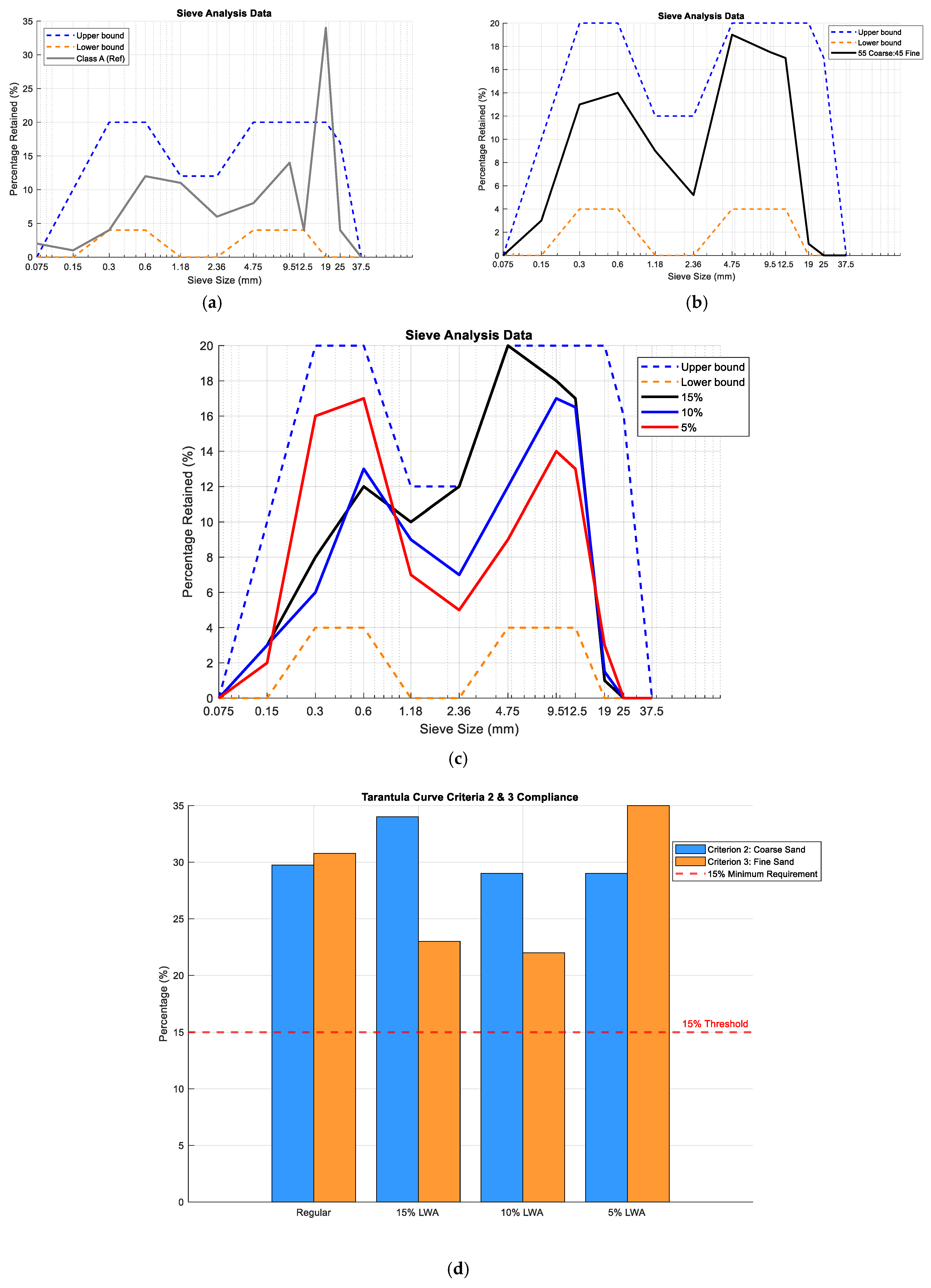
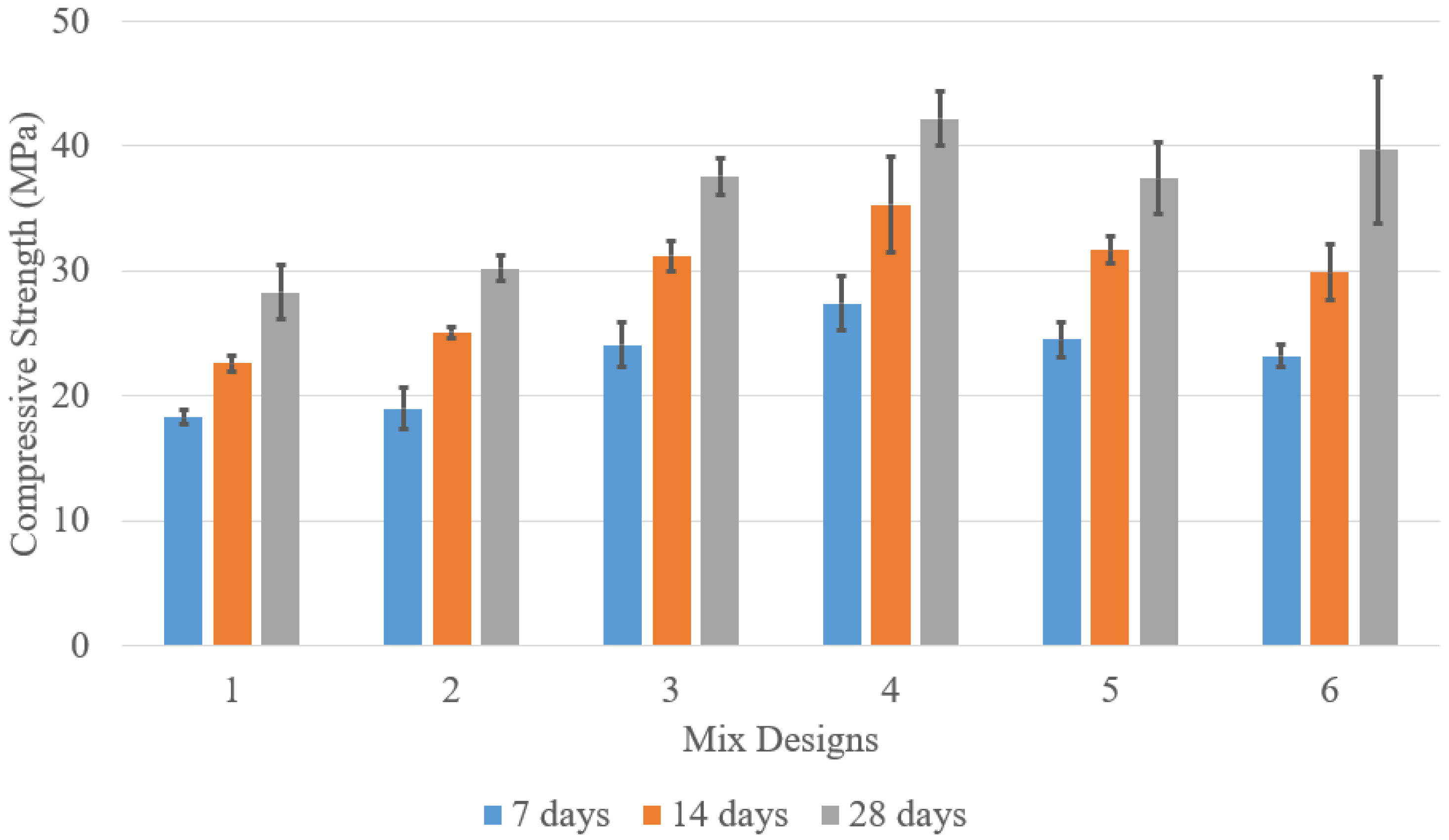
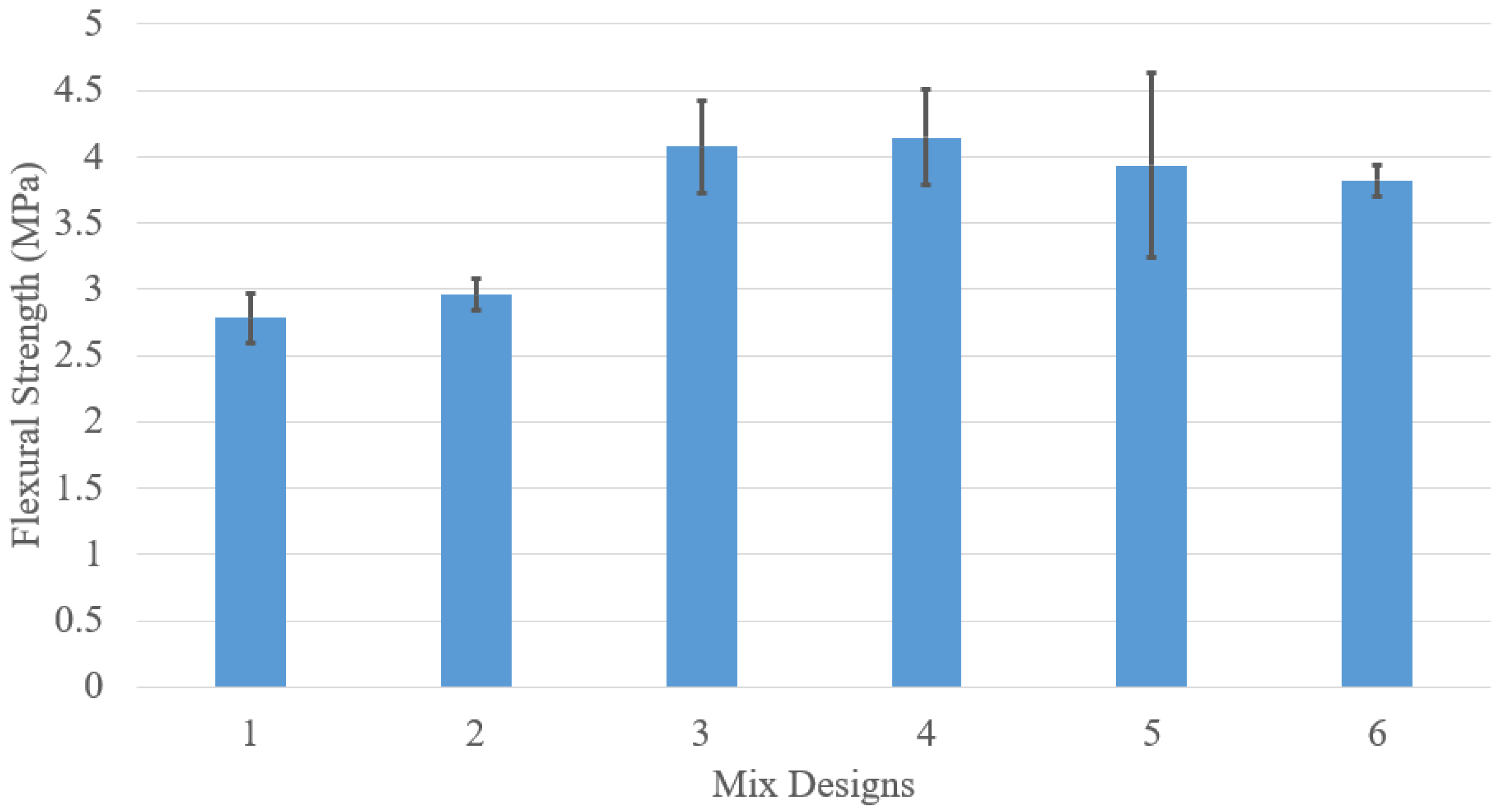

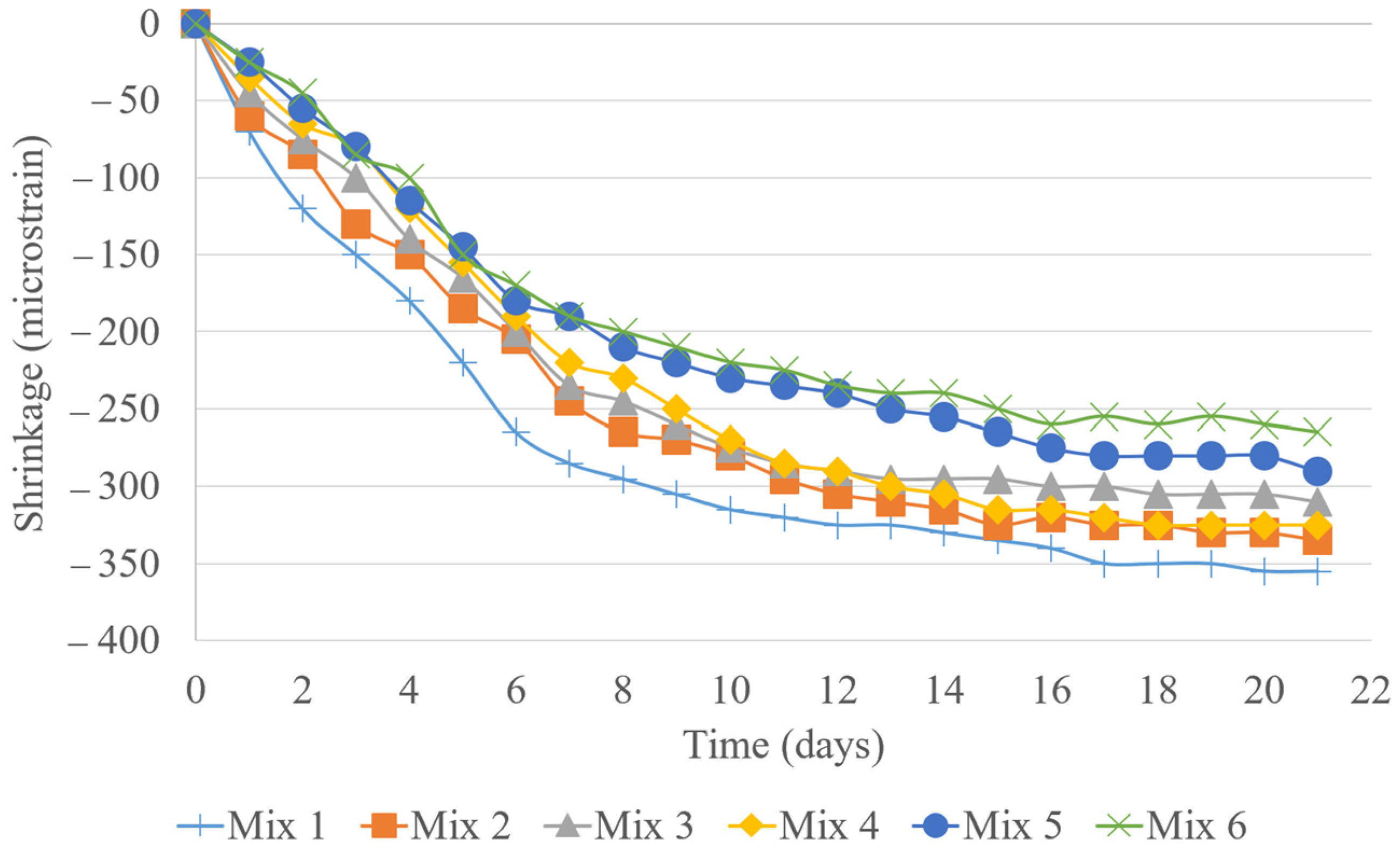
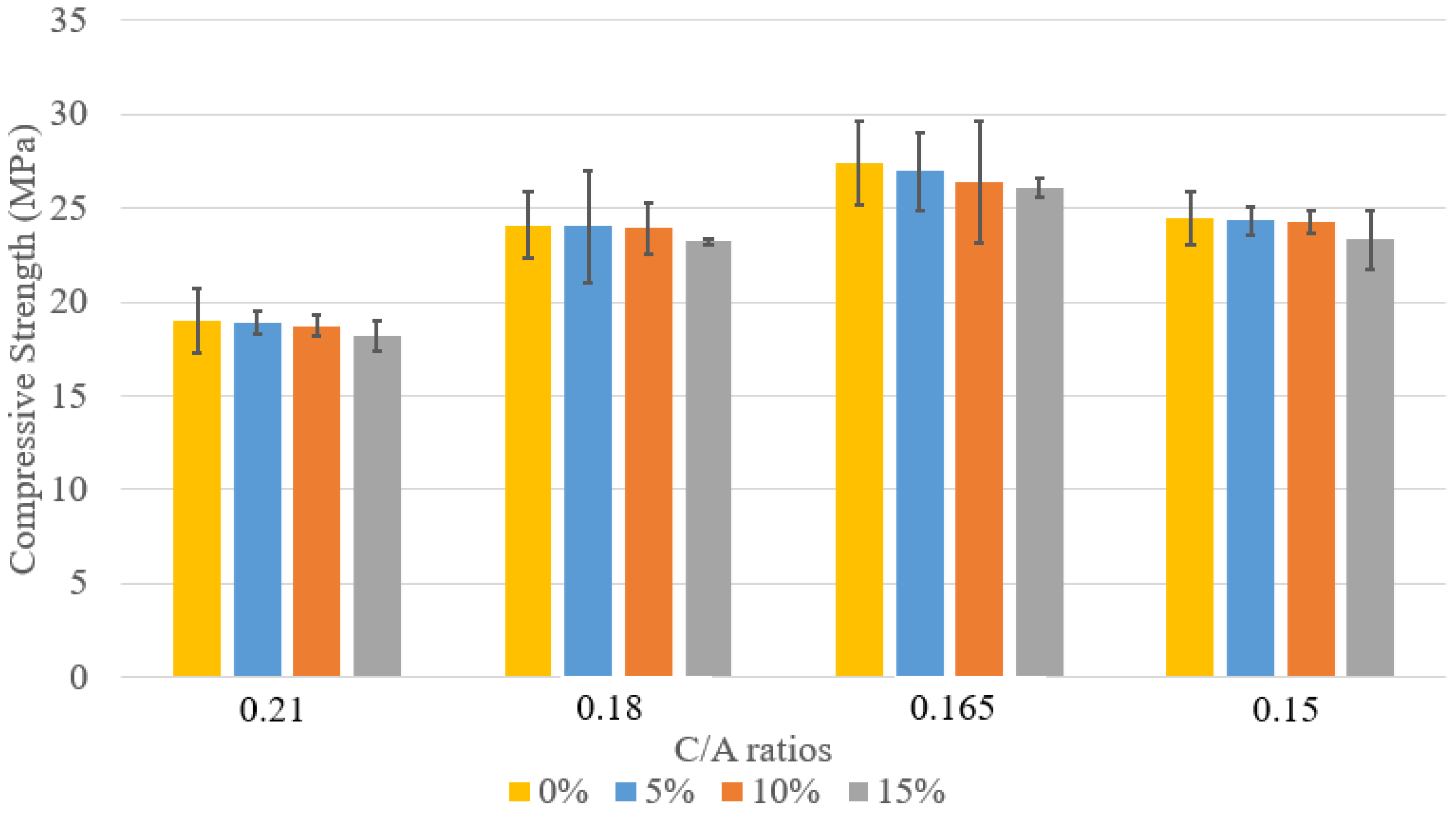
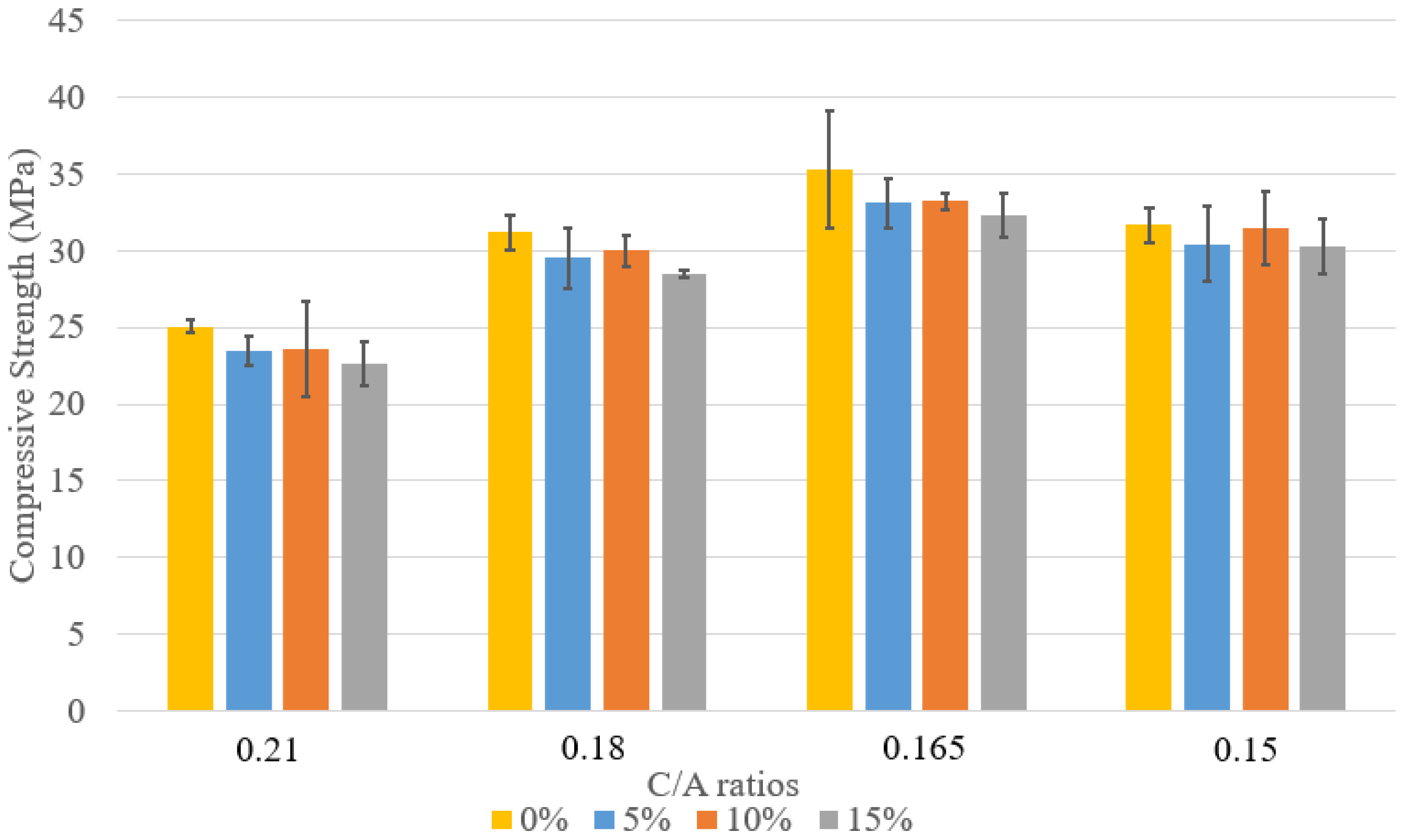
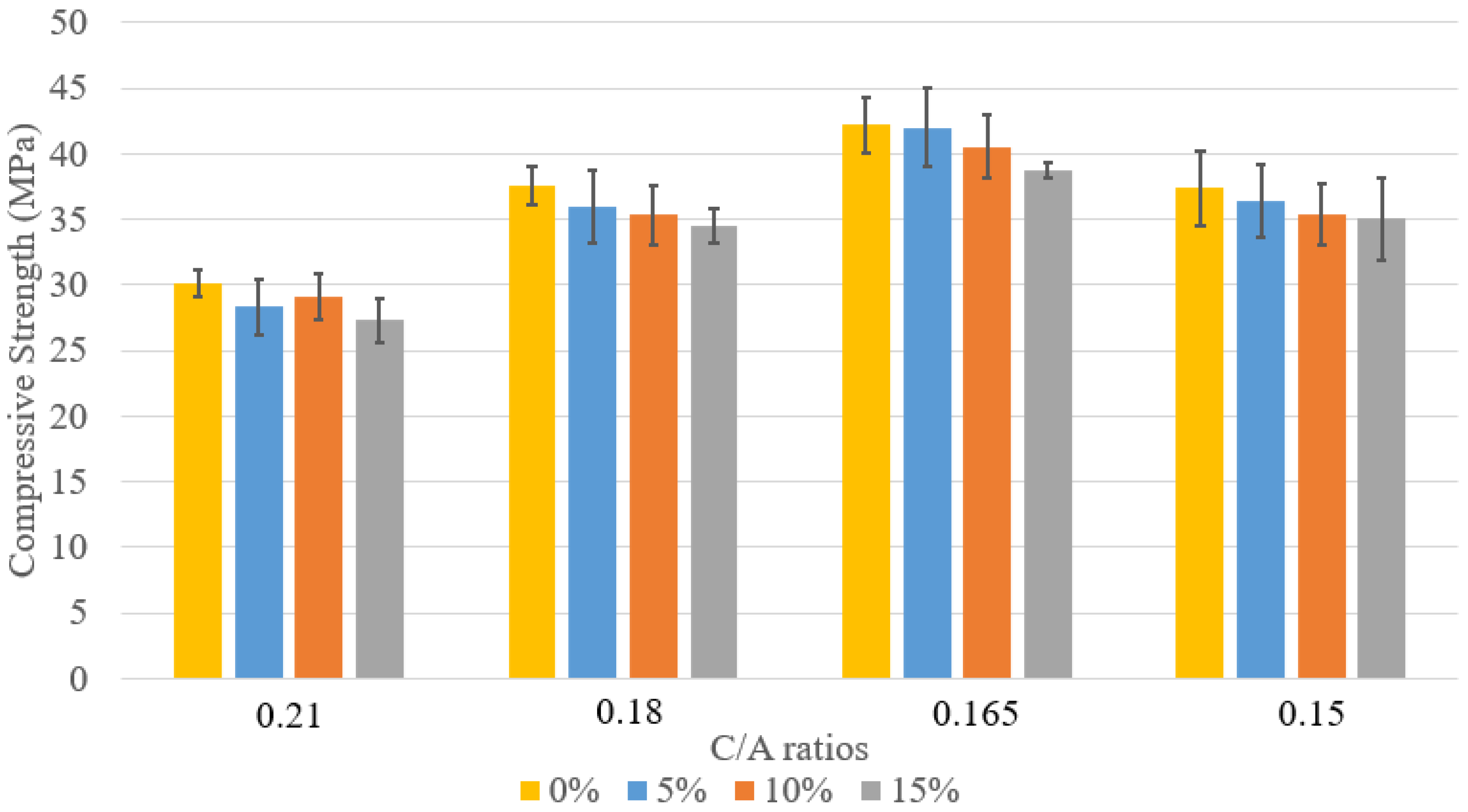
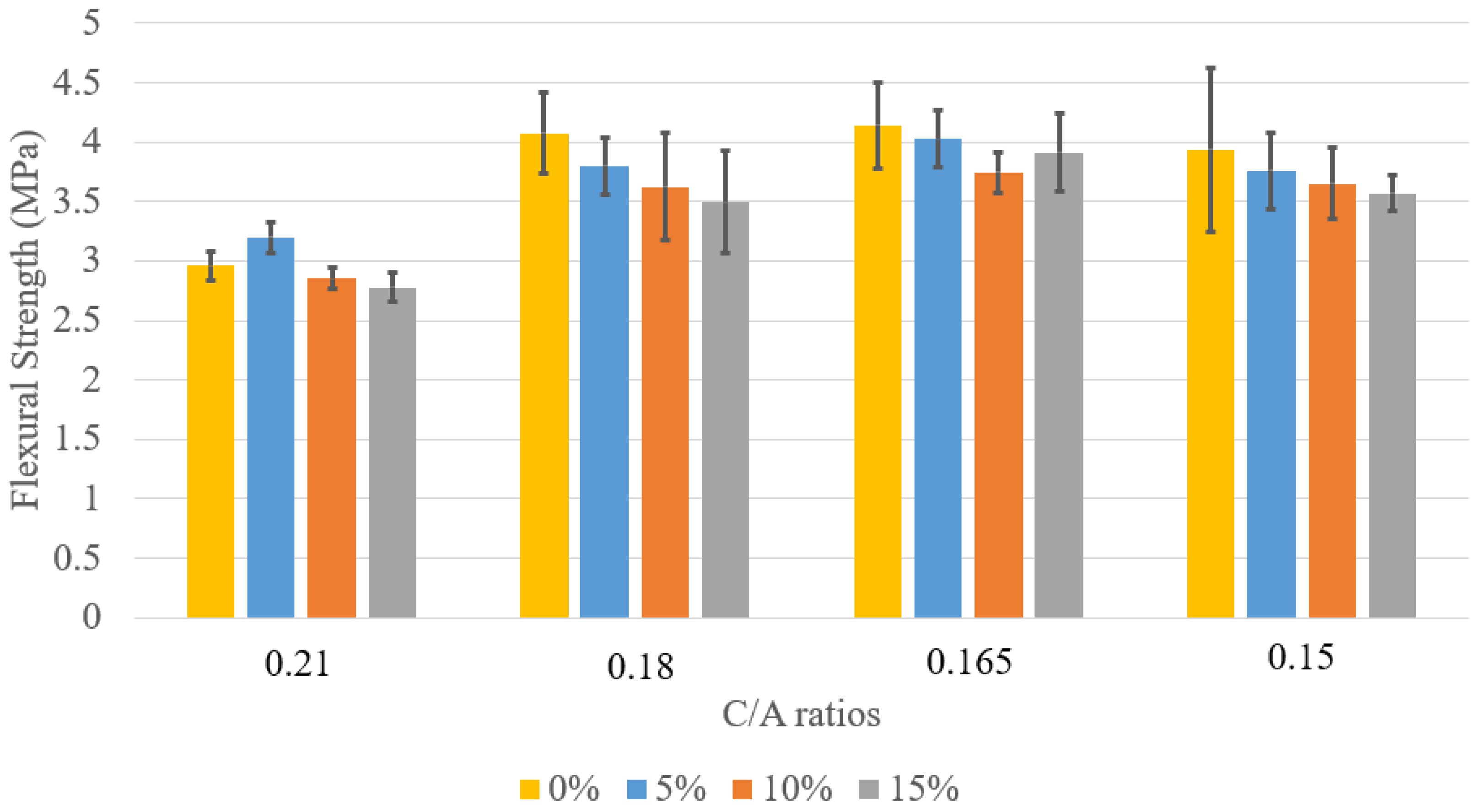
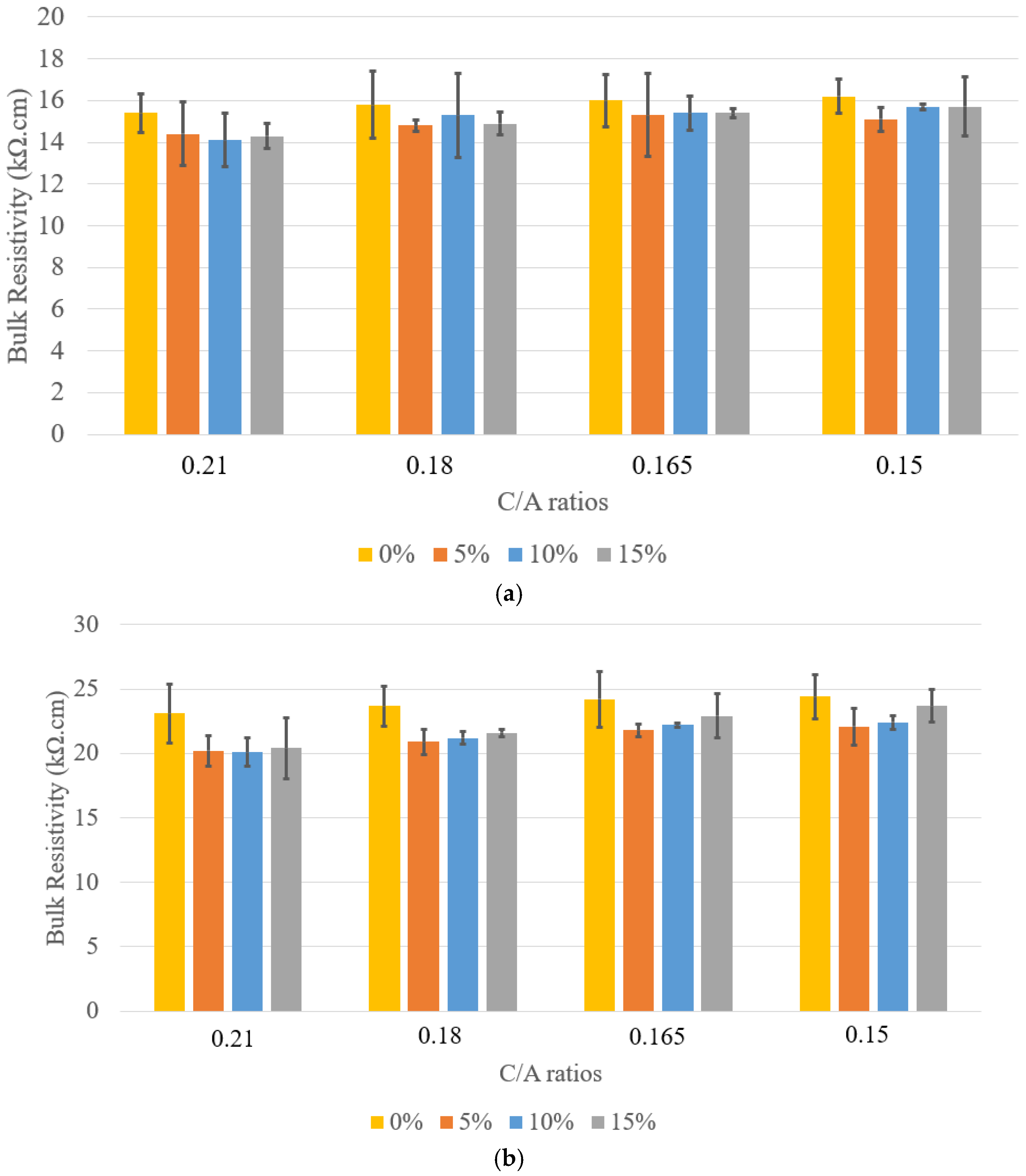

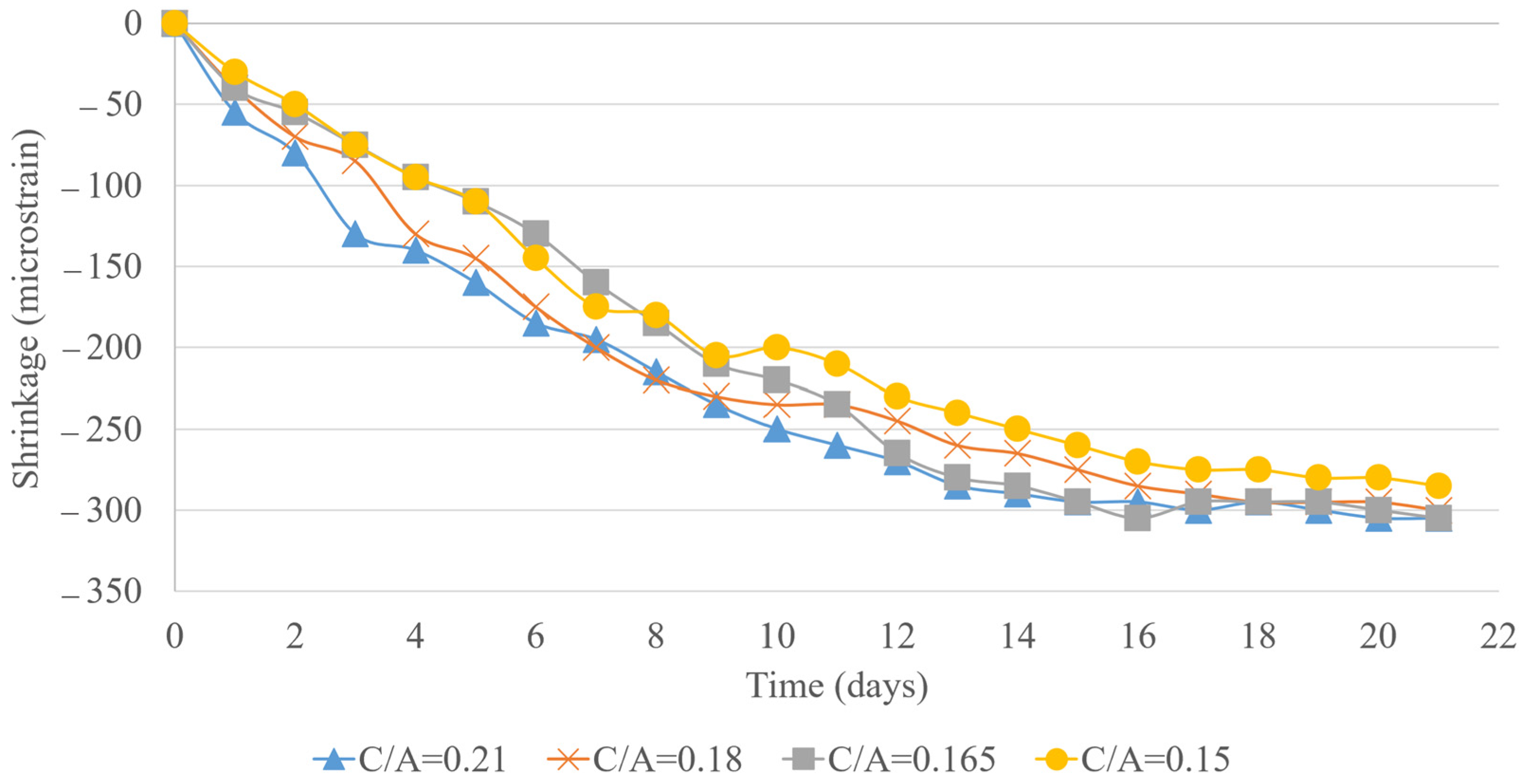
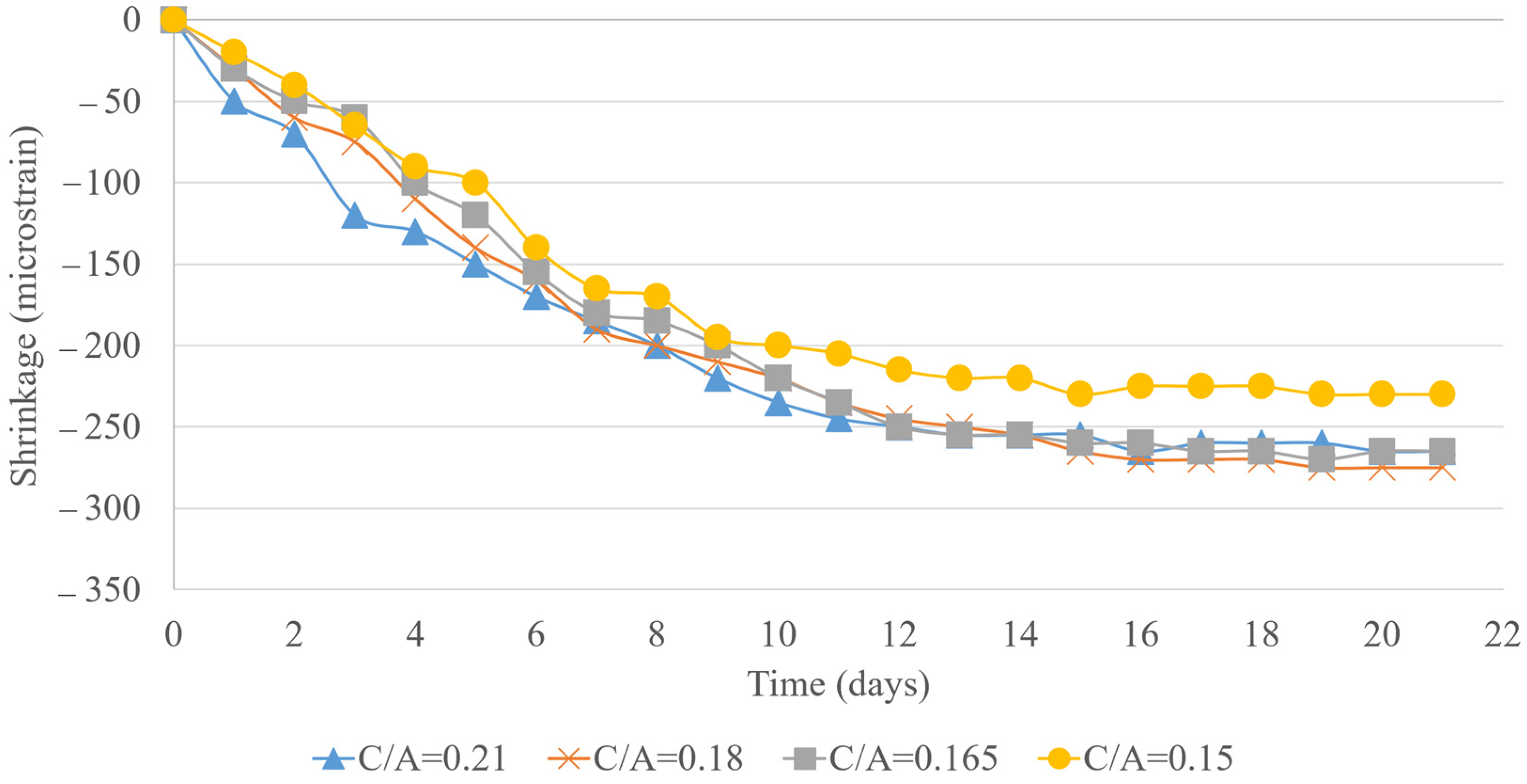
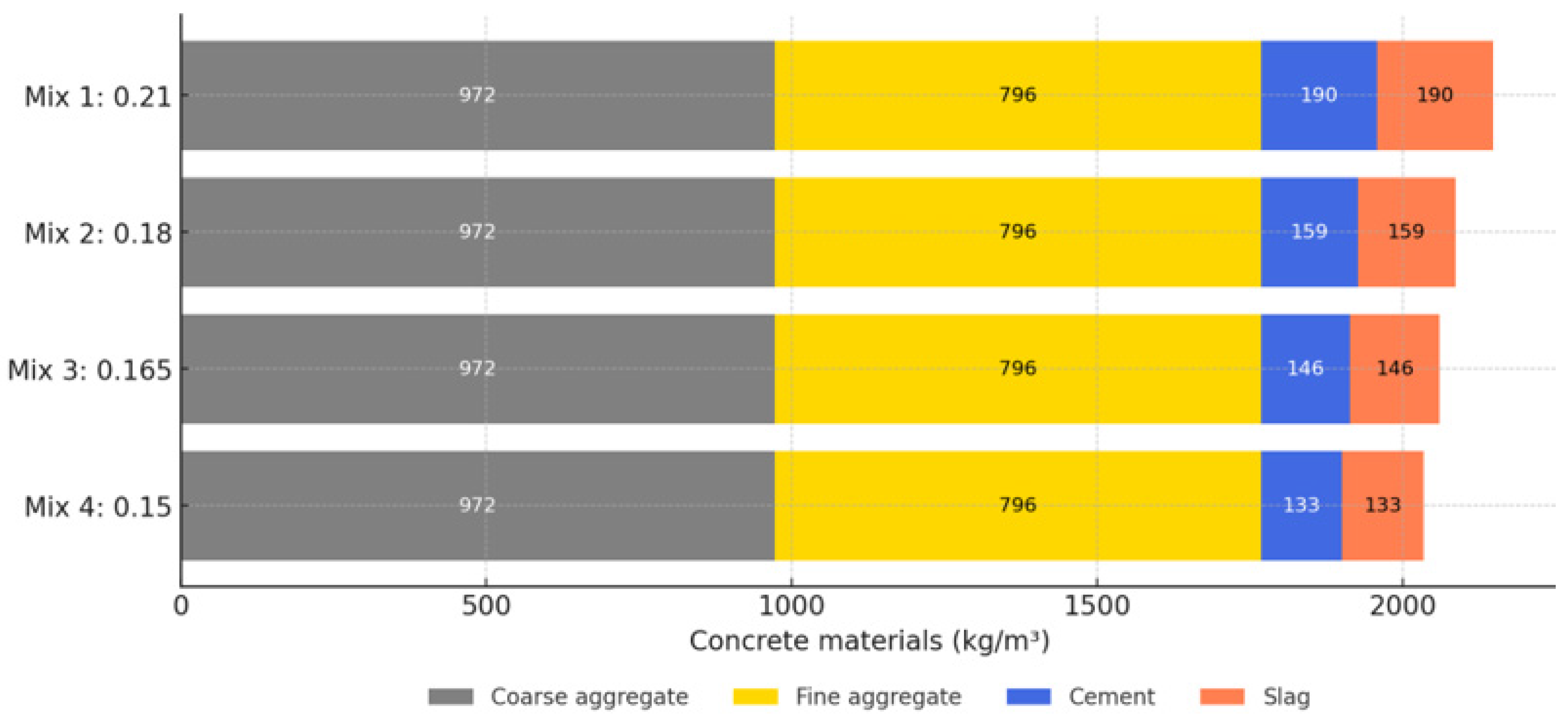
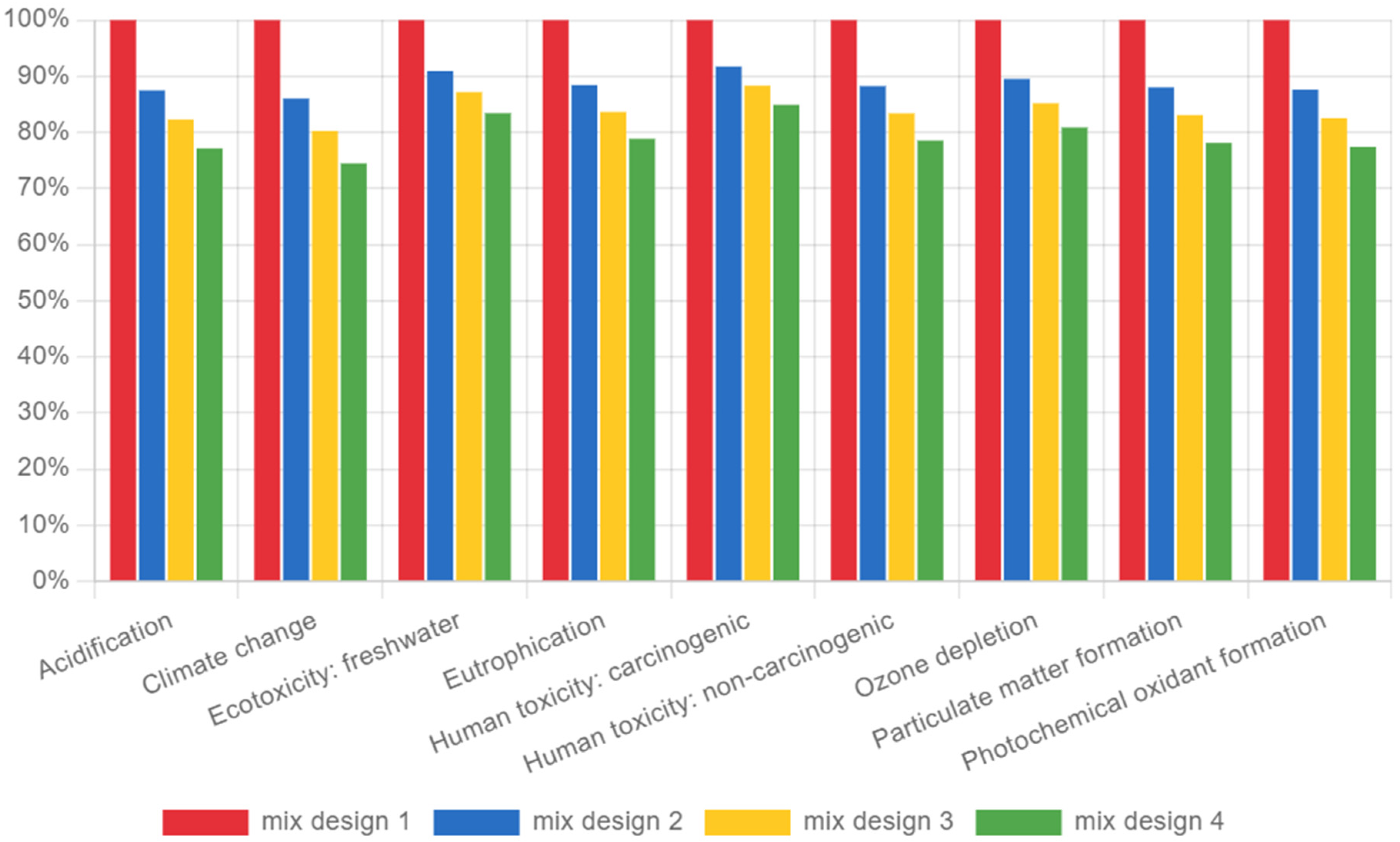
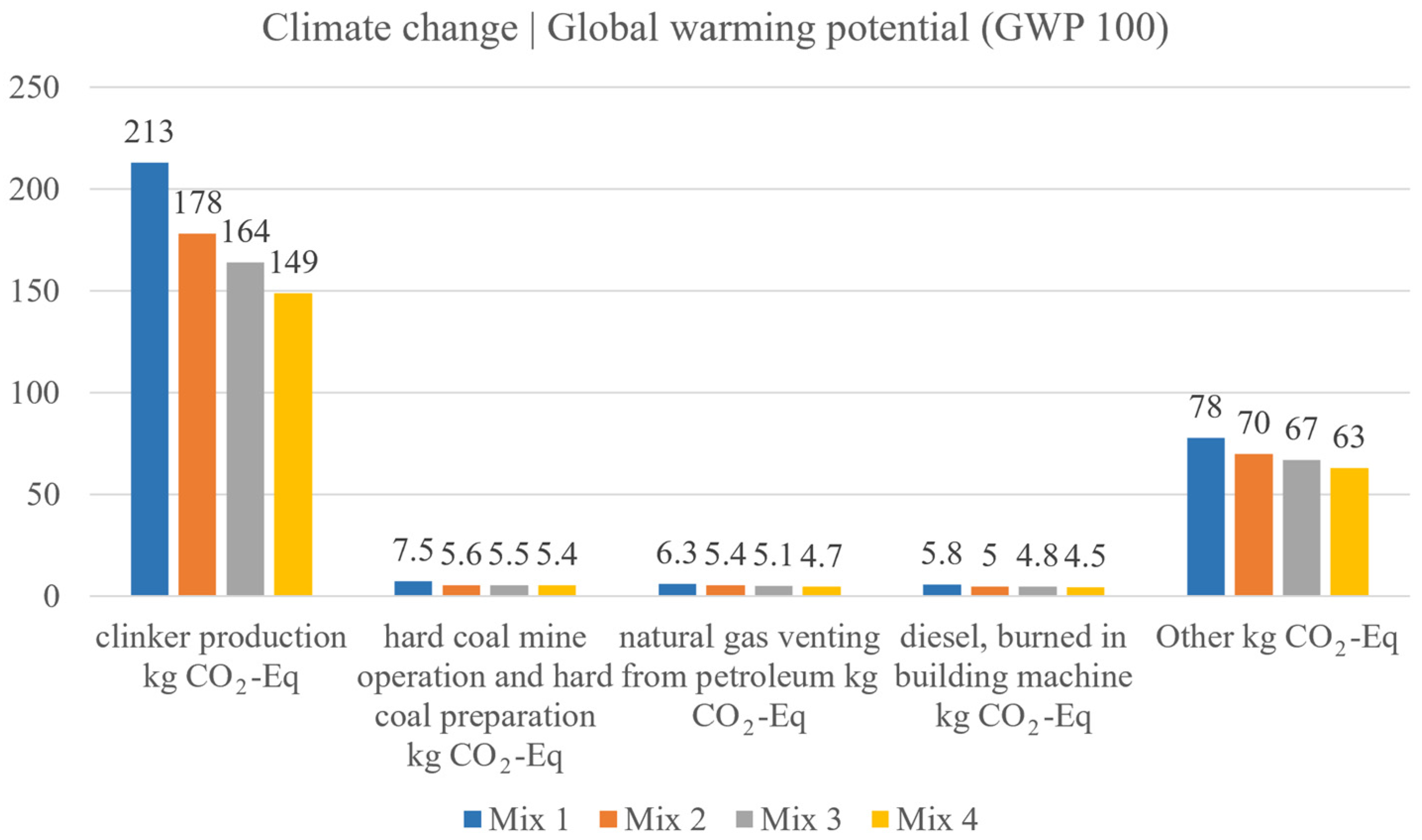
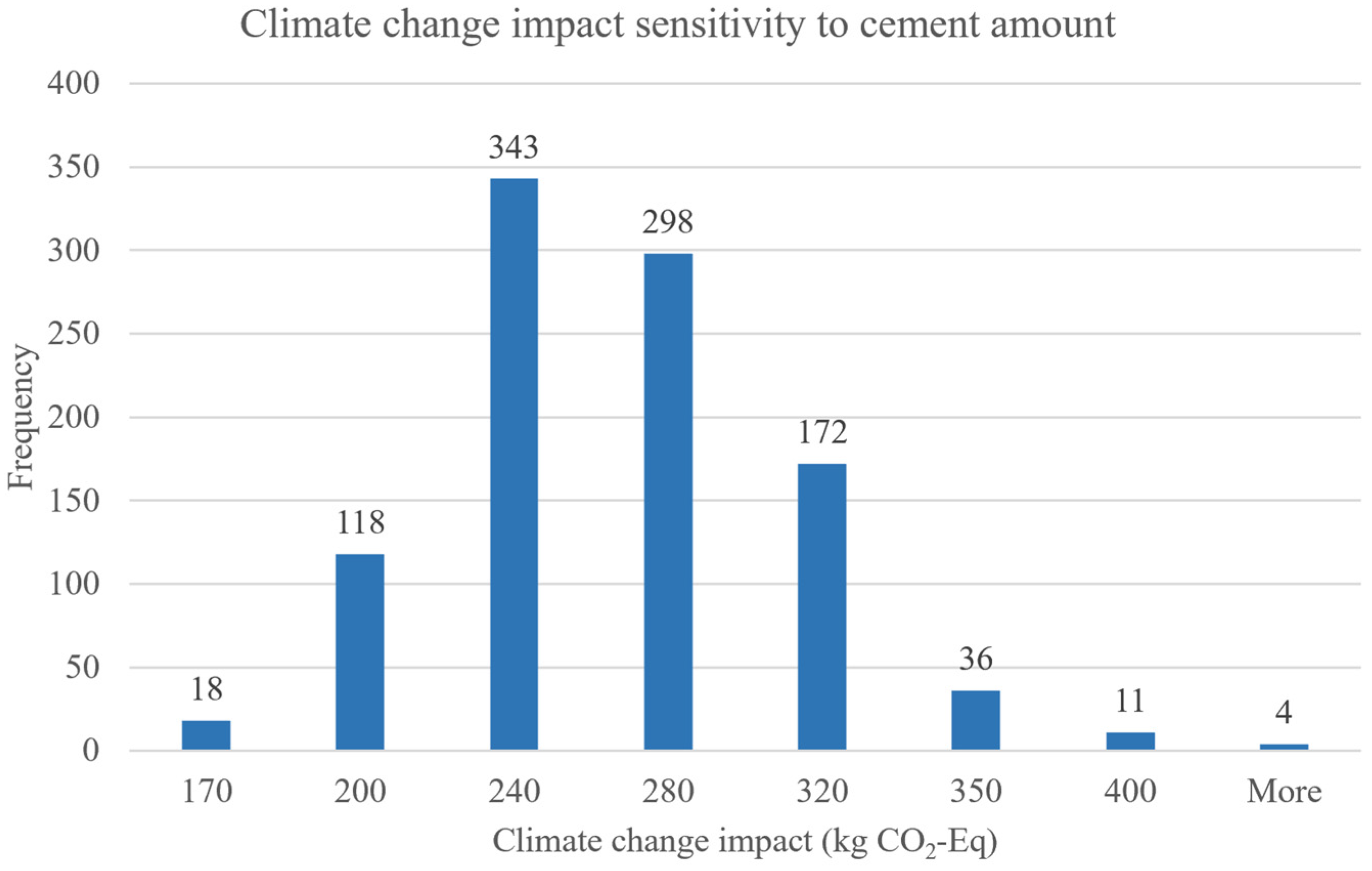
| Oxides | PLC (%) | Type II Cement (%) | Slag (%) |
|---|---|---|---|
| SiO2 | 20.2 | 21.5 | 32.70 |
| Al2O3 | 3.6 | 3.7 | 8.58 |
| Fe2O3 | 3.2 | 3.3 | 1.70 |
| CaO | 65.1 | 65.2 | 44.82 |
| MgO | 3.0 | 3.4 | 9.33 |
| SO3 | 3.4 | 3.3 | 1.16 |
| Na2O | 0.3 | -- | 0.30 |
| Criterion | Description |
|---|---|
| Criterion 1 | Aggregate gradation must lie within Tarantula curve boundaries. |
| Criterion 2 | ≥15% of total aggregate volume should be coarse sand (#8 to #30 sieve). |
| Criterion 3 | ≥15% of total aggregate volume should be fine sand (#30 to #200 sieve). |
| Mix Design | C/A Ratio | Cement (kg/m3) | Slag (kg/m3) | Water (kg/m3) | Coarse (kg/m3) | Fine (kg/m3) | LWFA (kg/m3) | HRWR (kg/m3) | AE (kg/m3) |
|---|---|---|---|---|---|---|---|---|---|
| 1 | 0.21 | 190 | 190 | 145 | 972 | 796 | 0 | 0.95 | 0.07 |
| 2 | 0.21 | 190 | 190 | 145 | 972 | 796 | 0 | 0.95 | 0.07 |
| 3 | 0.18 | 159 | 159 | 143 | 972 | 796 | 0 | 1.13 | 0.07 |
| 4 | 0.165 | 146 | 146 | 131 | 972 | 796 | 0 | 1.51 | 0.07 |
| 5 | 0.15 | 133 | 133 | 120 | 972 | 796 | 0 | 2.27 | 0.07 |
| 6 | 0.15 | 133 | 133 | 120 | 884 | 884 | 0 | 2.27 | 0.07 |
| 7 | 0.21 | 190 | 190 | 145 | 972 | 530 | 265 | 0.95 | 0.07 |
| 8 | 0.18 | 159 | 159 | 143 | 972 | 530 | 265 | 1.14 | 0.07 |
| 9 | 0.165 | 146 | 146 | 131 | 972 | 530 | 265 | 1.13 | 0.07 |
| 10 | 0.15 | 133 | 133 | 120 | 972 | 530 | 265 | 1.23 | 0.07 |
| 11 | 0.21 | 190 | 190 | 145 | 972 | 619 | 177 | 1.17 | 0.07 |
| 12 | 0.18 | 268 | 268 | 241.5 | 972 | 619 | 177 | 0.97 | 0.07 |
| 13 | 0.165 | 246 | 246 | 221.4 | 972 | 619 | 177 | 1.17 | 0.07 |
| 14 | 0.15 | 224 | 224 | 201.5 | 972 | 619 | 177 | 1.30 | 0.07 |
| 15 | 0.21 | 320 | 320 | 244 | 972 | 708 | 88 | 0.58 | 0.07 |
| 16 | 0.18 | 268 | 268 | 241.5 | 972 | 708 | 88 | 0.85 | 0.07 |
| 17 | 0.165 | 246 | 246 | 221.4 | 972 | 708 | 88 | 1.03 | 0.07 |
| 18 | 0.15 | 224 | 224 | 201.5 | 972 | 708 | 88 | 1.18 | 0.07 |
| Test Type | Specimen Dimensions | Number per Mix | Ages Tested | Purpose | Standards |
|---|---|---|---|---|---|
| Slump | Fresh mix | 1 | Fresh | Workability evaluation | ASTM C143 |
| Compressive Strength | 100 × 200 mm cylinders | 3 | 7, 14, 28 days | Strength development | ASTM C39 |
| Flexural Strength | 150 × 150 × 500 mm beams | 3 | 28 days | Bending performance | ASTM C78 |
| Bulk Resistivity | 100 × 200 mm cylinders | 3 | 28, 56 days | Durability/resistivity | AASHTO TP 119-21 |
| Shrinkage | 76 × 76 × 286 mm prisms | 3 | Daily for 21 days | Total shrinkage | ASTM C157 |
| Mix 1 | Mix 2 | Mix 3 | Mix 4 | Mix 5 | Mix 6 |
|---|---|---|---|---|---|
| 132 mm | 139 mm | 127 mm | 114 mm | 73 mm | 89 mm |
| Compressive Strength (MPa) | Flexural Strength (MPa) | Total Shrinkage () | Bulk Resistivity (KOhm-cm) | |
|---|---|---|---|---|
| 0% LWFA | 37.39 ± 2.87 | 3.94 ± 0.69 | 290 ± 12 | 24.4 ± 1.50 |
| 5% LWFA | 36.40 ± 2.76 | 3.76 ± 0.32 | 285 ± 14 | 22.1 ± 1.43 |
| 10% LWFA | 35.41 ± 2.37 | 3.65 ± 0.30 | 265 ± 21 | 22.4 ± 0.55 |
| 15% LWFA | 35.05 ± 3.19 | 3.57 ± 0.16 | 230 ± 13 | 23.7 ± 1.27 |
Disclaimer/Publisher’s Note: The statements, opinions and data contained in all publications are solely those of the individual author(s) and contributor(s) and not of MDPI and/or the editor(s). MDPI and/or the editor(s) disclaim responsibility for any injury to people or property resulting from any ideas, methods, instructions or products referred to in the content. |
© 2025 by the authors. Licensee MDPI, Basel, Switzerland. This article is an open access article distributed under the terms and conditions of the Creative Commons Attribution (CC BY) license (https://creativecommons.org/licenses/by/4.0/).
Share and Cite
Najaf, E.; Orouji, M.; Li, L.; Landis, E.N. Development of Sustainable, Low-Shrinkage Concrete Through Optimized Aggregate Gradation, Cement Reduction, and Internal Curing. Materials 2025, 18, 2194. https://doi.org/10.3390/ma18102194
Najaf E, Orouji M, Li L, Landis EN. Development of Sustainable, Low-Shrinkage Concrete Through Optimized Aggregate Gradation, Cement Reduction, and Internal Curing. Materials. 2025; 18(10):2194. https://doi.org/10.3390/ma18102194
Chicago/Turabian StyleNajaf, Erfan, Maedeh Orouji, Linfei Li, and Eric N. Landis. 2025. "Development of Sustainable, Low-Shrinkage Concrete Through Optimized Aggregate Gradation, Cement Reduction, and Internal Curing" Materials 18, no. 10: 2194. https://doi.org/10.3390/ma18102194
APA StyleNajaf, E., Orouji, M., Li, L., & Landis, E. N. (2025). Development of Sustainable, Low-Shrinkage Concrete Through Optimized Aggregate Gradation, Cement Reduction, and Internal Curing. Materials, 18(10), 2194. https://doi.org/10.3390/ma18102194






